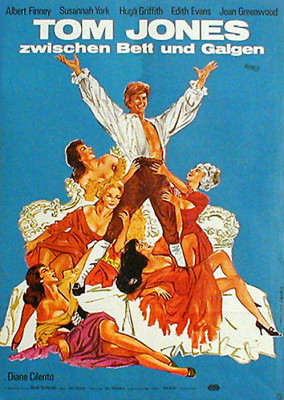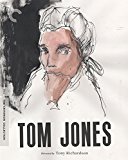| Reviews & Columns |
|
Reviews DVD TV on DVD Blu-ray 4K UHD International DVDs In Theaters Reviews by Studio Video Games Features Collector Series DVDs Easter Egg Database Interviews DVD Talk Radio Feature Articles Columns Anime Talk DVD Savant Horror DVDs The M.O.D. Squad Art House HD Talk Silent DVD
|
DVD Talk Forum |
|
|
| Resources |
|
DVD Price Search Customer Service #'s RCE Info Links |
|
Columns
|
|
|
Tom Jones
Sometimes I get it wrong and so looked forward to Criterion's new Blu-ray, which features both the 121-minute 1989 director's cut and the original, 1963 theatrical version, running 128 minutes. Alas, my reaction was much as before. While I admired parts of it, it still strikes me as not very good, especially when compared with the so many wonderful British comedies that came immediately before and after it.
And, yet, Tom Jones was a critical and commercial smash, winning Academy Awards for Best Picture, Best Director (Tony Richardson), Best Score (John Addison), and Best (Adapted) Screenplay (John Osborne), as well as nominations for Best Actor (Albert Finney) and four of its supporting cast (Hugh Griffith, Diane Cilento, Edith Evans, and Joyce Redman). Made for a modest $1 million, it initially earned rentals (i.e., profits) of about $20 million during its initial run, making it phenomenally successful.
Why? One reason, surely, was that it deftly balances a kind of classiness with singularly British sauciness mainstream American audiences found palatable. Its stateliness served as a counterweight to its sex-heavy storyline at a time when the Production Code and the Catholic Legion of Decency were quickly losing ground and movies were taking more chances. Tom Jones was Hot Stuff in 1963, though even in the prudish America of today it's so tame it could air without cuts on commercial television in the middle of the afternoon.
Another reason, I suspect, is that audiences in America had limited widespread exposure to British comedies prior to Tom Jones. There were certainly exceptions, but the majority of British comedies at the time were mostly limited to art house circuit distribution. The Ealing-type films that came before and the more raucous Carry On-type that came after weren't widely seen in America at the time so Tom Jones, for most moviegoers, was an entirely new experience.
Adapted from Henry Fielding's 1749 novel The History of Tom Jones, a Foundling, the movie follows the life of its lusty title character (Finney), scandalously born out of wedlock and raised by country Squire Allworthy (George Devine). As a handsome, spirited young lad, Tom falls for Sophie Western (Susannah York), the daughter of ribald drunk Squire Western (Hugh Griffith). Tom, however, is stigmatized by his "bastard" status and unequivocally beneath her high station, and though Squire Western likes Tom personally, presses Sophie to marry Blifil (David Warner, pimply-faced in his feature debut), a conniving, snooty boor. Further, Tom can't help but bed down all the women who desire him. The long, episodic picture follows Tom through his various sexual escapades and escapes from angry husbands, sadistic Redcoats, and others who would see him hanged.
Interestingly, neither director Richardson (who died of AIDS in 1991) nor star Albert Finney was terribly pleased with the film. Richardson admitted later that he "botched" a lot of it, with cinematographer Walter Lassally correctly adding that Richardson's endless post-production tinkering damaged the finished product. Finney, on the other hand, quite rightly felt the part wasn't serious enough, that he "was being used," and indeed the character of Tom Jones is paper-thin. His love for Sophie isn't believable and except for the seduction scenes with the various women, Finney has little to work with.
The picture tries way too hard to please. On several occasions characters "break the fourth wall," which seems counterproductive to the period verisimilitude it tries so hard to establish. Tom Jones opens with a silent movie-style prologue, which seems completely pointless, given its 18th century setting. Worst of all is Richardson's use of fast-motion, which reeks of desperation and is usually reserved for cheap comedies like AIP's Beach Party movies.
John Addison's harpsichord-dominated score is undeniably sprightly, but it much too aggressively cues the audience with its preciousness. By the halfway point I found it distracting and mostly intrusive.
All this works against Tom Jones' good points. Watching it again, I was struck by the degree its story mirrors Stanley Kubrick's later Barry Lyndon (1975), a darkly funnier movie even though it's mostly a drama. Like that film, Richardson is concerned with the hypocrisies and cruelties of English gentlemanliness. The film's best sequence is a spectacularly filmed hunting vignette, during which poultry gets trampled and the hunters dig into their horses with their sharp spurs until their animals bleed. In an amusing touch, when Griffith's squire gorges on greasy meat, so sloppy is he that a glop of fat dangles from his wig.
A few performances stand out. Edith Evans has a wonderful little bit with a would-be highwayman; Joan Greenwood and David Tomlinson, stalwarts of British film comedy during the 1950s, appear late in the film, almost as insurance; Diane Cilento, Sean Connery's wife at the time, is fine as York's rival in the first act.
There's little doubt that the success of Tom Jones had a profound impact on British filmmaking for the remainder of the decade but, in terms of laughs, Britain's earlier Ealing comedies were subtler and more amusing, while the concurrent, increasingly saucy Carry On films, some of which ventured into similar period comedy (Don't Lose Your Head, Carry On Dick, etc.) provided a lot more honest laughs.
Video & Audio
Tom Jones has always been a problematic title. During my long-ago days at MGM we fretted over entire missing reels of Tom Jones' original camera negative. Criterion used this incomplete OCN for most of the film, filling the gaps using no less than three interpositives and two internegatives. The results are mostly good if less than perfect, especially during optically-printed dissolves and fades, when the image is notably grainy. Director of photography Lassally provided detailed instruction about the color grading, which during some of the day-for-night footage (rather than night-for-night, more common in British films at the time) seems modernized as it appears more color-drained and darker than original 35mm prints probably were. The Director's Cut, remixed for Dolby Stereo, utilizes a 35mm Dolby A magnetic master. To my ears it amplifies the music track a bit too much, and a few throwaway bits of dialogue are barely audible. Both 1.66:1 widescreen masters include optional English subtitles and are region "A" encoded.
Extra Features
Supplements include featurettes on the film's cinematography; a new interview with film scholar Duncan Petrie on the film's place in British cinema; an excerpt from a 1982 Dick Cavett Show featuring Finney; a new interview with Richardson's former wife Vanessa Redgrave; an audio interview with John Addison; and a new interview with Robert Lambert, editor of the Director's Cut. A booklet essay by Neil Sinyard rounds out the extra features.
Parting Thoughts
Worth seeing for sure but nearly as wonderful as its reputation suggests, the film's good points, the improved transfer, and the supplements make Tom Jones Recommended.
Stuart Galbraith IV is the Kyoto-based film historian largely absent from reviewing these days while he restores a 200-year-old Japanese farmhouse.
|
| Popular Reviews |
| Sponsored Links |
|
|
| Sponsored Links |
|
|
| Release List | Reviews | Shop | Newsletter | Forum | DVD Giveaways | Blu-Ray | Advertise |
|
Copyright 2024 DVDTalk.com All Rights Reserved. Legal Info, Privacy Policy, Terms of Use,
Manage Preferences,
Your Privacy Choices | |||||||
















